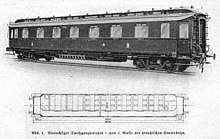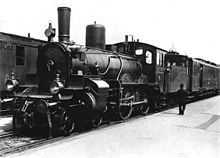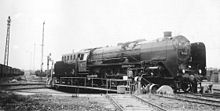D 31/32 (Cologne – Berlin)
The D 31/32 between Cologne and Berlin via Paderborn , Hameln , Hildesheim and Braunschweig was the first German express train . It was introduced in 1892 by the Prussian State Railways and operated on a largely unchanged schedule until it was discontinued due to the war in 1945 . After 1945 it was replaced by a pair of express trains between Cologne and Braunschweig in a comparable time slot, which carried through coaches to and from Berlin. This pair of trains was discontinued by the Deutsche Bundesbahn after 99 years when the timetable changed in the summer of 1991 .
introduction
In the first few years after the introduction of the railway in Germany, there was initially no differentiated train service. As a rule, the passenger trains stopped at all stations, sometimes as mixed trains and freight cars. From around 1850, the German railway companies gradually introduced faster trains that did not stop at all intermediate stations. These were initially referred to as "courier trains " and from 1889 onwards as " express trains ". However, the fleet of cars did not differ from conventional passenger trains and, with a few exceptions, consisted of two- and three-axle compartment cars in almost all German states , in which each compartment could only be reached via external doors. A change to the dining car introduced in 1880 was only possible at train stations, and it was just as difficult to go to the toilet .
The travel comfort possible with the previous compartment cars was no longer sufficient, especially for wealthy passengers. In other European countries and by the Compagnie Internationale des Wagons-Lits , increasingly longer four-axle wagons with bogies had been introduced from around 1880 , which offered better driving comfort. At the suggestion of Edmund Heusinger von Waldegg , the Prussian State Railways finally introduced a new type of wagon, the compartment wagon with a side aisle , known as a “ passage car ” .
The first express train was introduced on May 1, 1892. The S 31/32, which has been running between Berlin Potsdamer Bahnhof and Cologne Central Station since last year , was the first pair of trains to receive the new through coaches. The pair of trains did not run on the fastest route between Berlin and Cologne via the Lehrter Bahn , Hanover and Minden , but on a much slower and sometimes single-track route via Magdeburg , Braunschweig, Hildesheim , Hameln , Altenbeken , Paderborn and Soest . The reason why a faster pair of trains via Hanover was not selected as the first express train can probably be explained on the one hand by the health resort Bad Pyrmont between Hameln and Altenbeken, where the D 31/32 stopped at the station. Back then, Bad Pyrmont, as a world-famous spa, was the destination of many wealthy spa guests from the nobility and wealthy bourgeoisie. On the other hand, the route via Hanover and Löhne was already heavily burdened by the existing traffic, while the routes used by the D 31/32 still had capacity reserves. The driving time of just under nine hours was therefore quite competitive. While express trains were previously marked with an “S” or “Sz”, the S 31/32, like the other trains formed from the new wagons, received the abbreviation “D” from 1893 and only 1st and 2nd class wagons.
Until World War II
The D 31/32 initially consisted of four 1st and 2nd class cars and a mail / baggage car. To reduce weight, no dining car was initially carried, but one of the passenger cars was given a small kitchen compartment. However, this soon proved to be inadequate and the train was supplemented by a dining car. After some of the D-trains introduced later were soon given third-class cars, the D 31/32 was also given third-class cars in 1900 as the first D-train between Cologne and Berlin.
The worst accident hit the D 31 on December 20, 1901. Shortly before the Altenbeken station , the following passenger train drove onto the D 31, which had come to a halt due to a horse being run over. The Altenbeken railway accident claimed 12 lives and 27 injured.
From 1904 the D 31/32 received a through car to and from Paris . In 1914 the D 31/32 had the following timetable:
| D 31 | railway station | D 32 |
|---|---|---|
| 08:42 | Cologne central station | 22:26 |
| 09:31 | Elberfeld Hbf | 21:42 |
| 09:39 | Barmen Central Station | 21:33 |
| 10:08 | Hagen (Westf) | 21:07 |
| 10:37 | Unna | - |
| 11:03 | Soest | 20:07 |
| 11:22 | Lippstadt | 19:47 |
| 11:53 | Paderborn Hbf | 19:21 |
| 12:17 | Altenbeken | 19:01 |
| 12:56 | Bad Pyrmont | 18:18 |
| 13:17 | Hamelin | 17:59 |
| 14:06 | Hildesheim Central Station | 17:11 |
| 14:51 | Braunschweig Hbf | 16:28 |
| 16:05 | Magdeburg Central Station | 14:59 |
| 17:07 | Brandenburg Stsbf | 13:53 |
| 17:38 | Potsdam Central Station | 13:24 |
| 18:01 | Berlin Potsdamer station | 13:00 |
In the last pre-war timetable for the summer of 1939, the travel times had been reduced by almost an hour compared to 1914, while the situation was largely unchanged. The D 31 left Cologne at 8:32 a.m. to arrive at Berlin Potsdamer Bahnhof at 5:02 p.m. In the opposite direction, he left Berlin at 1:50 p.m. and reached Cologne Central Station at 10:20 p.m. The D 31/32 remained in the timetable until the end of the Second World War , until the Deutsche Reichsbahn stopped its remaining long-distance traffic on January 23, 1945 in view of the war situation.
post war period
The division of Germany into zones of occupation prevented the unaltered resumption of train operations after 1945. At the end of the 1940s, what was now the Deutsche Bundesbahn , however, reintroduced the D 31/32, although it was shortened to the West German section of the route between Cologne and Braunschweig. After the Berlin blockade was over , the railway resumed train services between what was now the Federal Republic and Berlin. The D 31/32 was not extended to Berlin again, but the pair of trains received through cars to and from Berlin. In contrast, travelers had to do without a dining car, which was replaced by a minibar . In 1969 the Federal Railroad introduced new train numbers, the traditional designation D 31/32 was replaced by the train numbers D 640/641. With the introduction of the Intercity '79 concept , the pair of trains received the new numbers D 840/841, ten years later the numbers were changed one last time to D 2740/2741. The train route between Cologne and Braunschweig via Paderborn and Bad Pyrmont, however, remained unchanged over the entire period, and the train also kept its Berlin through cars. In the 1990/91 winter timetable, the train left Cologne Hbf at 10:56 a.m. and reached Braunschweig at 3:27 p.m. The Berlin Friedrichstrasse station was reached by coaches at 19:03.
It was only with the fundamental change in the long-distance network due to the commissioning of the high-speed lines and the introduction of the ICE and the effects of German reunification , with the change to the 1991 summer timetable, the then oldest long-distance train pair in Germany on June 2, 1991. Since then, long-distance transport has not been offered between Altenbeken and Hildesheim.
Vehicle use
The Prussian State Railways initially hauled the train with their standard express train locomotives of the types S 2 and S 3 . After the introduction of their last express train locomotives of the type S 10 , this was soon used before the D 31/32. The covering is only known again during wartime, in 1943 the Reichsbahn used the class 01 before the train pair, which at that time was very heavy with a train weight of 550 tons. Most recently, the train between Cologne and Hameln was hauled by class E 10 locomotives. Due to the non-electrified route between Hameln and Elze, class 218 diesel locomotives hauled the train between Hameln and Braunschweig.
literature
- Wolfgang Klee: Out after 99 years. The oldest express train in Germany will soon no longer run. in: Eisenbahn Magazin 3/91, p. 16, ISSN 0342-1902
- Andreas Knipping : The express train. A German invention. in: Bahn-Extra 6/2007: Der D-Zug, pp. 12-24, ISBN 978-3-89724-193-0
- Wolfgang Klee: Taking the curves. Long-distance trains on the Hanover-Altenbekener Railway and the "Gleis 200". Focal points of north-south traffic after the Second World War, part 2. in: Railway history October 42 / November 2010, pp. 28–37, ISSN 1611-6283
Individual evidence
- ↑ D-Trains, in: Röll, Freiherr von: Enzyklopädie des Eisenbahnwesens, Volume 3. Berlin, Vienna 1912, pp. 492–493
- ↑ Wolfgang Klee: From after 99 years. The oldest express train in Germany will soon no longer run. in: Eisenbahn Magazin 3/91, p. 16, ISSN 0342-1902
- ^ Reich course book summer 1914
- ↑ Andreas Knipping: The express train. A German invention. in: Bahn-Extra 6/2007: Der D-Zug, p. 15





